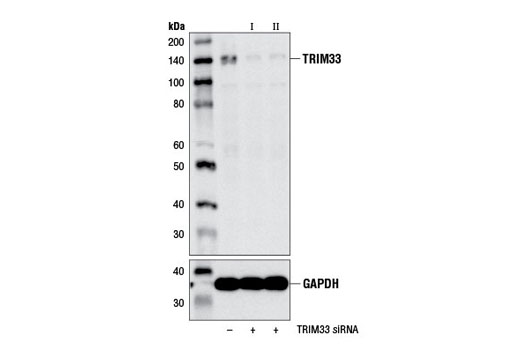#Q9UPN9
51592
Product Information
Product Usage Information
CST recommends transfection with 100 nM SignalSilence® TRIM33 siRNA II 48 to 72 hours prior to cell lysis. For transfection procedure, follow protocol provided by the transfection reagent manufacturer. Please feel free to contact CST with any questions on use.
Each vial contains the equivalent of 100 transfections, which corresponds to a final siRNA concentration of 100 nM per transfection in a 24-well plate with a total volume of 300 μl per well.
Storage
Specificity / Sensitivity
Species Reactivity:
Human
Product Description
Background
The transcriptional intermediary factor 1 (TIF1) family represents a group of proteins with multiple histone-binding domains. In humans, this family comprises four proteins, TIF1α/TRIM24, TIF1β/TRIM28/KAP1, TIF1γ/TRIM33/Ectodermin, and TIF1δ/TRIM66, which are characterized by an amino-terminal tripartite motif (TRIM) domain consisting of a RING domain, two B boxes, a coiled-coil domain, and a carboxy-terminal PHD finger and bromodomain (1). Despite their similar overall structure, these proteins have diverse roles in transcriptional regulation. TIF1α functions as a ligand-dependent nuclear receptor coregulator and more recently has been implicated in regulating p53 stability (2). TIF1β is an intrinsic component of the N-CoR1 corepressor complex and the NuRD nucleosome-remodeling complex (3) and functions as a corepressor for Kruppel-associated box (KRAB) zinc-finger transcription factors (4). Furthermore, TIF1β promotes heterochromatin-mediated gene silencing formation by serving as a cofactor for heterochromatin protein HP1 (5). TIF1δ expression is restricted to the testis and has been shown to interact with HP1γ (6).
In contrast, the ubiquitous nuclear protein TRIM33 does not interact with either HP1 family members or chromatin-remodeling/modifying complexes. Rather, TRIM33 plays a pivotal role in signaling cascades driven by the TGF-β superfamily of ligands (7-9). A research study suggests that TRIM33 and Smad4 compete for binding to receptor phosphorylated Smad2/3 and that TRIM33-Smad2/3 and Smad4-Smad2/3 complexes complement one another in the TGF-β-dependent control of hematopoietic cell fate (9). Other studies, however, demonstrate that TRIM33 functions to repress signal relay by the TGF-β superfamily (7-8,10). Indeed, knockout of murine Trim33 results in embryonic lethality due to upregulated Nodal signaling (10). Mechanistically, TRIM33 functions as an E3-ubiquitin ligase and promotes monoubiquitination of Smad4, a modification that impairs its ability to associate with phospho-Smad2 (8). This negative regulatory mechanism is further substantiated by the discovery that TRIM33 disrupts transcriptionally competent Smad complexes on the promoter/enhancer regions of TGF-β-responsive genes by associating with specific epigenetic marks on histone H3, which is a requirement for activating TRIM33's monoubiquitin ligase activity toward Smad4 (11). In line with the ability of TRIM33 to regulate the development of different blood cell lineages, it was shown that loss of TRIM33 expression due to epigenetic silencing of its promoter contributes to the pathogenesis of chronic myelomonocytic leukemia (12).
- Meroni, G. and Diez-Roux, G. (2005) Bioessays 27, 1147-57.
- Jain, A.K. and Barton, M.C. (2009) Cell Cycle 8, 3668-74.
- Underhill, C. et al. (2000) J Biol Chem 275, 40463-70.
- Schultz, D.C. et al. (2001) Genes Dev 15, 428-43.
- Groner, A.C. et al. (2010) PLoS Genet 6, e1000869.
- Khetchoumian, K. et al. (2004) J Biol Chem 279, 48329-41.
- Dupont, S. et al. (2005) Cell 121, 87-99.
- Dupont, S. et al. (2009) Cell 136, 123-35.
- He, W. et al. (2006) Cell 125, 929-41.
- Morsut, L. et al. (2010) Development 137, 2571-8.
- Agricola, E. et al. (2011) Mol Cell 43, 85-96.
- Aucagne, R. et al. (2011) J Clin Invest 121, 2361-70.
Species Reactivity
Species reactivity is determined by testing in at least one approved application (e.g., western blot).
Cross-Reactivity Key
H: human M: mouse R: rat Hm: hamster Mk: monkey Vir: virus Mi: mink C: chicken Dm: D. melanogaster X: Xenopus Z: zebrafish B: bovine Dg: dog Pg: pig Sc: S. cerevisiae Ce: C. elegans Hr: horse GP: Guinea Pig Rab: rabbit All: all species expected
Trademarks and Patents
使用に関する制限
法的な権限を与えられたCSTの担当者が署名した書面によって別途明示的に合意された場合を除き、 CST、その関連会社または代理店が提供する製品には以下の条件が適用されます。お客様が定める条件でここに定められた条件に含まれるものを超えるもの、 または、ここに定められた条件と異なるものは、法的な権限を与えられたCSTの担当者が別途書面にて受諾した場合を除き、拒絶され、 いかなる効力も効果も有しません。
研究専用 (For Research Use Only) またはこれに類似する表示がされた製品は、 いかなる目的についても FDA または外国もしくは国内のその他の規制機関により承認、認可または許可を受けていません。 お客様は製品を診断もしくは治療目的で使用してはならず、また、製品に表示された内容に違反する方法で使用してはなりません。 CST が販売または使用許諾する製品は、エンドユーザーであるお客様に対し、使途を研究および開発のみに限定して提供されるものです。 診断、予防もしくは治療目的で製品を使用することまたは製品を再販売 (単独であるか他の製品等の一部であるかを問いません) もしくはその他の商業的利用の目的で購入することについては、CST から別途許諾を得る必要があります。 お客様は以下の事項を遵守しなければなりません。(a) CST の製品 (単独であるか他の資材と一緒であるかを問いません) を販売、使用許諾、貸与、寄付もしくはその他の態様で第三者に譲渡したり使用させたりしてはなりません。また、商用の製品を製造するために CST の製品を使用してはなりません。(b) 複製、改変、リバースエンジニアリング、逆コンパイル、 分解または他の方法により製品の構造または技術を解明しようとしてはなりません。また、 CST の製品またはサービスと競合する製品またはサービスを開発する目的で CST の製品を使用してはなりません。(c) CST の製品の商標、商号、ロゴ、特許または著作権に関する通知または表示を除去したり改変したりしてはなりません。(d) CST の製品をCST 製品販売条件(CST’s Product Terms of Sale) および該当する書面のみに従って使用しなければなりません。(e) CST の製品に関連してお客様が使用する第三者の製品またはサービスに関する使用許諾条件、 サービス提供条件またはこれに類する合意事項を遵守しなければなりません。
